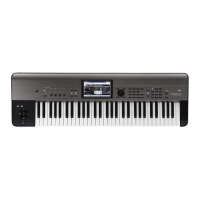Sequencer mode
170
• Parameter change messages of other than Sequencer
mode
*Unavailable* is shown in the following cases.
• KROME parameter change messages that cannot be
realtime‐recorded by the KROME, such as MIDI Channel,
Status, or Key/Vel Zone. (This corresponds to parameters
not in the table on page 191. Such cases may arise when
the parameter cannot be realtimerecorded by operating a
parameter on the KROME, but can be recorded when
received via MIDI.)
• KROME parameter change messages for which there is no
supported parameter, due to an input mistake or some
other reason
Note:
• IFX1, 2, 3, 4, 5, MFX1, MFX2, and TFX effect parameters
• Tone adjust
These parameter names and displayed values are the
parameter names and values for the corresponding effect.
(Effect parameters consisting of “Parameter” and a
“numeral” (e.g., Parameter71) are parameters not used by
the currently selected effect.)
If you’re recording parameter change messages to switch the
effect type, the parameter names will not be the
corresponding parameter names for the effect that is
originally selected at song playback; rather, the display will
show the parameters for the currently selected effect. Be
aware of this when switching effects, and when controlling
their parameters.
The BinEdit button will be available when an exclusive
message is selected. Pressing this button will open the
Binary Editor dialog box.
Here, a system exclusive message starting with F0 can be
edited in hexadecimal form. Use this when you want to
enter and edit a system exclusive message for an external
device.
The KROME’s system exclusive messages have the
following format.
F0: Exclusive status
42: Korg ID
3n: n=0...F Global MIDI channel
00: Model ID byte 1
01: Model ID bytes 2
15: Model ID bytes 3
ff: function ID
([41][04]: Sequencer mode parameter change)
...
F7: End of exclusive
• When you press the Test button, the currently‐edited
system exclusive message will be transmitted from the
MIDI OUT connector, USB MIDI connector, and EX‐FW
connector (if optionally installed). Use this when you
want to check the operation of an external device.
• Index [D] in the information box indicates the position of
the selected data within the message as a number of bytes
from the beginning of the message. Taking the starting F0
as zero, this is shown as 1, 2, 3, ... etc. (a decimal value).
Size [D] is a decimal value indicating the number of bytes
in the currently edited system exclusive. 16[D] indicates
that the message is sixteen bytes.
• Press the OK button to apply the settings.
• Use the data entry buttons to enter data as hexadecimal
values. The values 8, 9, A, B, C, D, E, and F are valid only
when entering the lower digit, where these values are
permitted.
• You can use the Insert button and Cut button to insert or
delete byte data.
• Press the OK button to apply the settings and return to
the event edit page.
6. When you are finished event editing, press the Done
button. If you press the COMPARE button you will
return the data to the condition in which it was before
you began event editing.
The following table shows the types of musical data that can
be edited by Event Edit and the range of their values.
*1: Be aware that because the time signature is recorded
in the master track, modifying it within any track will
affect all tracks at the same measure, causing them all to
play back with the modified time signature.
Note: *2: You can also enter the note data and velocity values
by holding down the ENTER button and playing a key.
*3: You cannot change Exclusive events into a different
type of event (e.g., a Note or Control Change event).
Nor can you change any other type of event into an
Exclusive event.
Pattern numbers will be displayed in locations in which a
pattern has been “put” (placed). At the end of the track there
will be an indication of Track End.
BAR (displayed only)
(Measure line)
Meter: 1/4...16/16 *1
(Time signature)
C–1...G9 *
2
(Note data)
V: 1...127 *
2
(Velocity)
L: 000.000...15984.000
(Length: beats, clocks)
PAFT
(Polyphonic after
touch)
C–1...G9
(Note number)
0...127
(Value)
CTRL
(Control change)
C: 0...119
(Control change
number)
0...127
(Value)
PROG
(Program
change)
Bank:A...E
000...127,
GM, g(1)..g(9) g(d), ––
–,
(Program bank)
P: 0...127,
1...128 (GM,
g(1)...g(d))
(Program number)
AFTT
(After Touch)
0...127
(value)
BEND
(Pitch bend)
–8192...+8191
(value)
EXCL *
3
(Exclusive)

